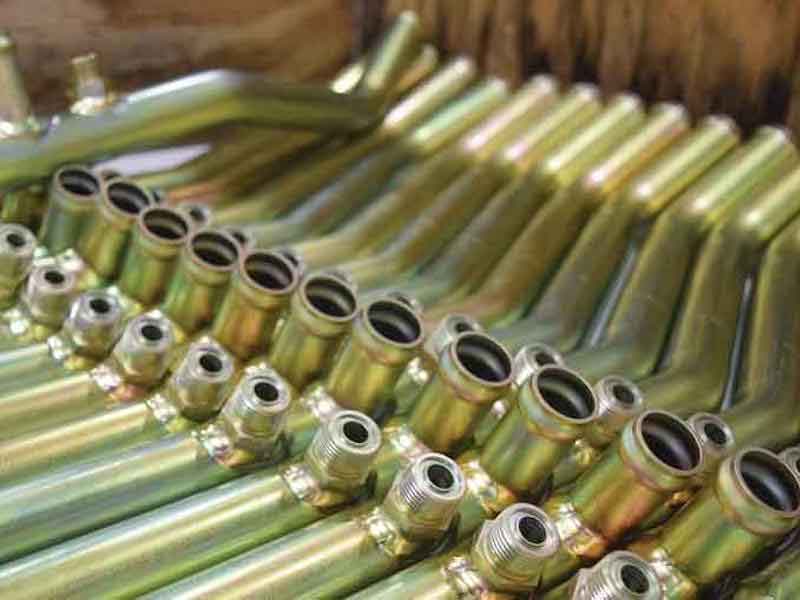Plating tube or pipe is a technical process but not necessarily a technical challenge. Successful plating hinges more on planning and logistics than the plating process itself.
 George Gatto Jr.Manufacturers that design tube or pipe components or assemblies need a corrosion-prevention strategy to protect both their products and their reputations. They have a few choices in achieving corrosion resistance: They can specify that the fabricator use a corrosion-resistant metal or apply paint or a powder coating, or they can stipulate that the metal should be plated.
George Gatto Jr.Manufacturers that design tube or pipe components or assemblies need a corrosion-prevention strategy to protect both their products and their reputations. They have a few choices in achieving corrosion resistance: They can specify that the fabricator use a corrosion-resistant metal or apply paint or a powder coating, or they can stipulate that the metal should be plated.
Successful plating, especially of pipe and tube products, depends on a number of factors, including how the fabricator presents its products to the plater, as well as the plater’s capabilities. These factors can have a significant effect on the end result, and it is essential that fabricators and platers communicate with each other to learn what their individual responsibilities are in achieving the best results.
Fabricators often start with a common question — “Plate first or form first?” — and this leads to many other questions. Exploring the answers to the many questions that surround plating tubular shapes is the path to a successful finish.
Choosing a Plating Partner
While most platers are well-qualified and successful with the customers they serve, not all of them can meet every fabricator’s plating objectives. Platers vary in their physical equipment, capabilities, experience, plating techniques, and secondary operations.
The fabricator’s key objective is to find a plater that matches the fabricator’s needs. Therefore, its initial questions to the plater should address the plater’s capacities, specific processes, and relevant experience. Knowing the number and size of the plater’s tanks, for instance, helps the fabricator gauge the plater’s ability to do the job and perhaps provides insight into the plater’s throughput. And, of course, the processes used by the plater help determine if it can handle the fabricator’s application.
Other essential questions might be secondary in nature but just as critical in finding a plater who can provide all of the services needed.
Can the plater blast scale or corrosion that might interfere with successful plating (see Figure 1)? How does it handle cleaning and plating fittings that may be included as an integral part of the product? Are its tanks not only large enough to hold all of the products but deep enough to allow the tube or pipe to be angled to facilitate sufficient coating bath coverage and drainage? How are the plated tubes or pipes stored following the plating process?
Most importantly, is the plater willing to work closely with the fabricator to address potential challenges to successful plating before they arise?
 Nearly anything on a tube or pipe’s surface interferes with the plating process. For a plating project to be successful, the fabricator and the plater must agree on the division of responsibilities—for example, blasting the OD to remove scale—before getting started.
Nearly anything on a tube or pipe’s surface interferes with the plating process. For a plating project to be successful, the fabricator and the plater must agree on the division of responsibilities—for example, blasting the OD to remove scale—before getting started.
Plating Straight Versus Formed Tubular Products
In regard to plating tube and pipe, the most common question concerns straight or formed products. Is it more effective to plate first, then form, or to form first, then plate?
The answer is: “It depends.”
 Removing corrosion and other contaminants from the ID, especially on bent products, is far more involved than removing them from the OD. Although many fabricators have the means to clean IDs, some platers prefer to incorporate this step as part of the plating process.For components with one or more hard bends (that is, a bend close to 90 degrees), it usually is best to plate before forming. Preparation for plating involves a bath in a cleaning solution to remove rust from both the ID and OD of the tube or pipe, and this is most effective when the solution can reach all surfaces, interior, and exterior, and can be drained completely after plating (see Figure 2). This can be challenging when bends trap air pockets, preventing the solution from reaching the entire ID surface and potentially leaving some rust or scale on the surface.
Removing corrosion and other contaminants from the ID, especially on bent products, is far more involved than removing them from the OD. Although many fabricators have the means to clean IDs, some platers prefer to incorporate this step as part of the plating process.For components with one or more hard bends (that is, a bend close to 90 degrees), it usually is best to plate before forming. Preparation for plating involves a bath in a cleaning solution to remove rust from both the ID and OD of the tube or pipe, and this is most effective when the solution can reach all surfaces, interior, and exterior, and can be drained completely after plating (see Figure 2). This can be challenging when bends trap air pockets, preventing the solution from reaching the entire ID surface and potentially leaving some rust or scale on the surface.
Straight products are easy to plate and handle, and they drain easily following plating, making the process more cost-effective. Furthermore, straight components can be packed more densely onto the plating racks, and, for that matter, they can be packed more densely for trucking to and from the plater, reducing the shipping costs.
If the fabricator chooses to plate after forming, can the prospective plater handle formed components? The plater’s tank size and configuration may be a limiting factor. Also, handling formed tube and pipe components requires experience and skill in manipulating the component to achieve total plating solution coverage and then to facilitate total drainage following plating. Such fabrications also require a more extensive drying process, which ultimately adds time and cost to the job.
A component involving less-acute bends, on the other hand, maybe almost as easy to handle and plate as a straight component, depending on the number and severity of the bends.
Forming After Plating
A related question concerns potential problems that can crop up when forming after plating. Completing a 90-degree bend can cause the plating to be compromised on the OD; lesser angles are not as susceptible to damage. On the ID, any areas that have not been cleaned thoroughly before plating may be difficult for the plater to clean. Even the diameter can be a factor, as smaller-diameter workpieces can experience greater stress than larger-diameter items during bending.
It also is possible that, although a coating remains in place after forming, the adhesion isn’t as strong as it was before forming. Therefore, it is necessary to limit the plating thickness to reduce the risk of adhesion failure. Welds, joints, and fittings also can present similar challenges. Brazing a terminal fitting to a pipe subjects the fitting and the rest of the local area to an intense amount of heat, which can accelerate rust formation on the ID. Beyond that, if a fitting moves during plating, it can result in unplated spots on the pipe, requiring manual repositioning in the middle of the plating process (see Figure 3).
Cleaning Before Plating
On-site cleaning by the plater can easily remove most grease, oil, light scale, and light rust. The fabricator is responsible for removing heavy ID rust (especially in the bends) and heavy scale (such as scale around brazed fittings). Also, not all platers have the capability to clean difficult-to-reach interior surfaces, so the fabricator should confirm this with the plater.
Fabricators should take note that areas of rust that are not thoroughly cleaned can continue to grow if there is a delay before plating takes place. This problem is especially critical when dealing with small-diameter workpieces, such as tubing intended for brake lines and other hydraulic applications. Corrosion and residual debris can plug small IDs, which is why eliminating all ID rust and debris is critical.
Choosing the Most Effective Coating
 Although a brazed three-piece fitting such as this one can add complexity to plating, it is still a good candidate for a successful outcome. Thorough application of the corrosion inhibitor requires moving the nut during the plating process. It’s important that the fabricator mention any moveable components so the plater can plan accordingly.Many plating materials are available, but despite the many choices, the majority of tube and pipe products are treated with zinc (galvanized). Zinc is used commonly because it is readily available and cost-effective.
Although a brazed three-piece fitting such as this one can add complexity to plating, it is still a good candidate for a successful outcome. Thorough application of the corrosion inhibitor requires moving the nut during the plating process. It’s important that the fabricator mention any moveable components so the plater can plan accordingly.Many plating materials are available, but despite the many choices, the majority of tube and pipe products are treated with zinc (galvanized). Zinc is used commonly because it is readily available and cost-effective.
Zinc plating bath types include acid zinc, alkaline (non-cyanide), and alkaline (cyanide). The specific choice must correspond to the required corrosion resistance result, which must correspond to how the workpiece is to be used. It is essential that the fabricator understands the differences and confirms that the plater uses the method that is best for the application.
For straight sections, for example, either an acidic or alkaline plating solution can be used. Either can provide a successful result, but an alkaline solution provides a better rust-preventive coating. It also produces a more ductile coating, which reduces the risk of adhesion failure during subsequent forming operations.
Storing Plated Products
Potential challenges do not disappear when the plating operation is finished. The plater should ensure that parts are dry before packing them. Once they are packed, the drying process essentially stops; restricted air circulation curtails the drying process. Any moisture that remains causes the coating to degrade.
Likewise, packed parts cannot dry if condensation is introduced during or after the packing process. If parts are stored in a humid environment or are subject to wide swings in temperature that cause condensation to form, the trapped moisture remains on the parts.
Collaboration—The Most Effective Plating Tool
The fabricator knows its products and what it requires from the plating process; the plater is experienced in plating a wide range of products. By communicating and collaborating with each other, they can together identify the challenges, work out strategies to overcome them, and achieve optimal solutions for each plating project.
The process order (bend first or plate first), cleaning before plating, and the storage method must be discussed thoroughly and agreed upon before plating begins. All of these considerations have to be optimized so the plating process is the best that it can be from the start. A do-over is not an option.
When such collaboration takes place and each party applies its expertise, the process goes as smoothly and successfully as possible.
George Gatto Jr. is the president of Gatto Industrial Platers Inc. in Chicago, IL. Call 800-290-1223 or visit www.gattoplaters.com



































